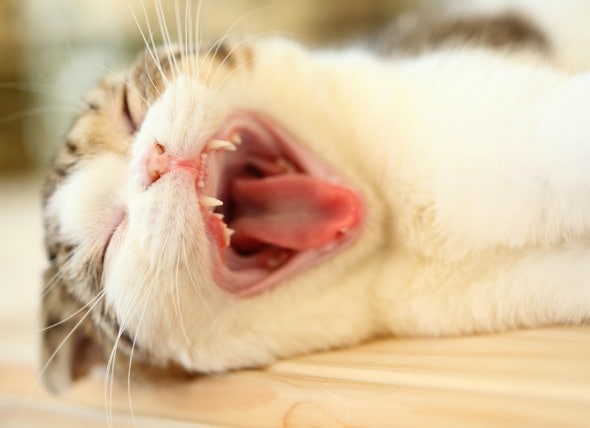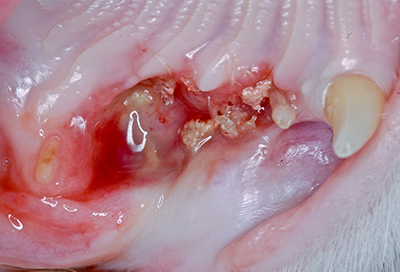sarcoma in cats jaw
In cats these tumors are often dark in color. Oral tumors come in many forms and your cats signs will depend on location of the tumor tumor type and tumor size.

Oral Squamous Cell Carcinoma In Cats An Overview Vet In Aurora The Animal Dental Clinic
June 1 2018 by Mallory Pfeifer.

. If the skin eruptions go unnoticed however the cancer can progress spread to other parts of the body and ultimately prove fatal. Squamous cell carcinoma SCC is the most common oral malignancy in the cat arising from either the jaw bones or the tongue. Tumors may look small but often extend deeper into the.
Tumors are locally invasive and can extend into the bones of the upper or lower jaw. The rate of metastasis at the time of diagnosis is low. My cat Momo is 9 years old and has a tumor on his jaw.
Tumors may appear as swellings on the gums around the teeth on the hard or soft palates. Some of them include liposarcoma fibrosarcoma spindle cell tumors and hemangiopericytomas. The provided history stated the cat had a lytic and proliferative lesion of the carpal bones.
Oral squamous cell carcinoma is cancer of the lining of the oral cavity including the gingiva gums tongue palate and tonsils. Fibrosarcomas arise from the connective tissues within the mouth often from the jaw bones. The whole episode started right around Christmas when he was showing signs of bad pain.
Skin tumors in general are the second most common type of feline cancer diagnosed at the Cornell University. Most salivary gland tumors are malignant with carcinomas and adenocarcinomas the most common types. Odontogenic tumors arise from the tissues making up the teeth.
What are the symptoms. If an osteosarcoma develops elsewhere in the skull or vertebrae swelling and pain in the. They are most commonly associated with the rabies vaccine.
Signs and Symptoms of Osteosarcoma in Cats. They frequently ulcerate break open and bleed. The cancer causes pain.
Symptoms How can you know if your cat has osteosarcoma. Mouth cancer is not connected to any breed age or sex of cat but experts believe second-hand smoke could contribute to its occurrence. Owners may notice a mass in the cats mouth.
Another treatment option is chemotherapy. Lameness that doesnt go away and swelling of the affected bone. Fibrosarcoma in Cats How we can help Call 530-752-1393 to schedule an appointment with the Oncology Service.
Cancer arises from osteoblasts or osteoclasts which are cells that produce a matrix which builds or breaks down bone. After many visits it was discovered that the lump was actually some sort of tumor but the vet wouldnt know exactly which kind without a biopsy. Often the symptoms will depend on the area of the body the cancer is affecting.
The local recurrence for upper jaw bone cancer is 83-100 and the majority of dogs with upper jaw. Metastasis to distant organs have not been reported in these dogs. Bone Cancer in Cats.
Osteosarcomas arise solely from bony tissues such as the jaw bones. These tumors generally appear as firm solitary often hairless or ulcerated lumps. Although squamous cell carcinomas dont spread rapidly to other parts of the body oral tumors may be locally invasive and spread to the chest.
The symptoms of bone cancer in cats include physical swelling lameness an abnormal gait and general unwellness. Jaw If the cancer is affecting the jaw you might notice they are having trouble opening their mouth and eating or lots of saliva in their mouth. Osteosarcoma die as a result of local tumor recurrence.
Bone cancer causes a number of signs of unwellness for two main reasons. By Judith Akins DVM MS. Squamous cell carcinoma SCC is a skin cancer that if caught in its early stage will most likely be harmless and easily treated.
They vary in size from less than 04 inches 1 centimeter to more than 4 inches 10 centimeters in diameter. Cats with osteosarcoma of the jaw a form of axial osteosarcoma may have swelling of the jaw difficulty opening the mouth excessive salivation and may be reluctant to eat due to pain. It is usually chosen to treat tumors with a higher likelihood of metastasis but can also be used as an effective method to target cancer cells in cats with vaccine-associated sarcomas.
These are the most common symptoms when a tumor affects a limb. This is often the first sign of a tumor in the skull jaw or ribs. Of the several types of cancerous oral growths that a cat can be affected by a squamous cell carcinoma is the most common one.
He told me the treatment for a benign. They usually occur in cats more than 10 years old. The physical swelling of the cancer causes mechanical.
Carcinomas can occur in any part of the body including the mouth. The lumps may stick out like stalks from the skin surface. Swelling or a mass.
A small piece of carpal bone from an eight-year-old domestic short haired cat DSH was submitted to the Texas AM Veterinary Medical Diagnostic Laboratory TVMDL for histopathology. It is the most common oral cancer in cats. Over the years research has been indicating that vaccines are associated with development of sarcomas in cats.
The two most common types of oral cancers that occur in cats include squamous cell carcinomas and fibrosarcomas. There are different forms of sarcoma that develop in cats. Osteosarcomas can also develop in the skull most commonly in the oral cavity pelvis ribs and vertebrae.
Tumors removed by surgery alone tend to recur so radiation treatment with or without surgery offers the best outlook in most cases. They may also become infected. Osteosarcoma osteogenic sarcoma is an aggressive and destructive type of primary cancer that develops in the bones.
It is the most common type of bone cancer in cats and accounts for 70 of bone tumours. Squamous cell carcinoma is an aggressive cancer in the cat and is often not diagnosed until the tumor is advanced. Symptoms and Type Excess salivation Bad breath halitosis Loose teeth Difficulty picking up food Difficulty chewing food dysphagia Blood coming from the mouth A growth in the mouth Weight loss.
Bone cancer causes an abnormal swelling to develop in the affected part of the skeleton. Download PDF of this Fibrosarcoma in Cats article Visit the Oncology Service website Vaccine associated fibrosarcomas are tumors that arise at sites where cats have been vaccinated. Mouth cancer can be a tumor located anywhere within a cats oral cavity including the lips tongue cheeks roof of the mouth upper or lower jaw and back of the mouth.
Cats suffering from oral tumors often develop jaw cancer or cancer in the oral cavity. The symptoms of osteosarcoma in cats can be subtle and they may include. The median survival for upper jaw osteosarcoma is 5-10 months after surgery with 17-27 of dogs being.
Such sarcomas are better known as Vaccine Associated Sarcomas. Bone Cancer in Cats. Other common causes of oral tumors in cats are fibrosarcomas osteosarcomas and odontogenic tumors.
These tumors grow very rapidly and typically invade nearby bone and tissue. Spread to nearby lymph nodes and the lungs is common. Alive one year later.
Chemotherapy consists of four to six treatments given at three-week intervals.

Feline Oral Squamous Cell Carcinoma Bishops Stortford Vets

Mouth Cancer Melanocytic In Cats Petmd

Dog Cat Oral Tumors Sacramento Veterinary Dentistry Services

Fibrosarcoma And Feline Sarcoid Vca Animal Hospitals

Mouth Cancer Gingiva Squamous Cell Carcinoma In Cats Petmd

Common Oral Tumors In Cats And Dogs Vet In Aurora The Animal Dental Clinic

Mouth Cancer In Cats Causes Symptoms Treatment All About Cats

Skullissima Bone Cancer Cranium Skull

My Cat S Battle With Oral Squamous Cell Carcinoma Ponnopozz Studio And Store

Oral Tumors In Cats An Overview Vca Animal Hospitals

My Cat S Battle With Oral Squamous Cell Carcinoma Ponnopozz Studio And Store

Oral Squamous Cell Carcinoma In Cats Northeast Animal Hospital

Cancerous And Non Cancerous Growths In A Cat S Mouth Petmd

Pet Talk Feline Oral Cancer A Silent But Deadly Disease In Cats Oregonlive Com

Oral Tumor Changes Cat S Eating Habits Boston Herald

Oral Squamous Cell Carcinoma In Cats An Overview Vet In Aurora The Animal Dental Clinic

Brain Tumors In Cats And Dogs Often The Most Challenging Of Cancers Brain Tumor Dog Treatment Dog Anatomy

